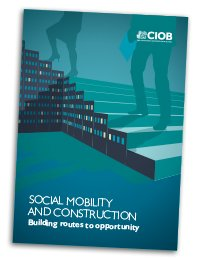Social mobility and construction: Building routes to opportunity
On 19 December 2016, the Chartered Institute of Building (CIOB) published a report highlighting the critical role construction plays in reversing declining levels of economic and social mobility in the UK.
Social Mobility and Construction: Building Routes to Opportunity suggests the construction sector is one of the few sectors that still employs a large number of traditional-skilled trades, roles that often lead onto more managerial positions. According to the report: ‘Construction in the UK now accounts for a third of all employment in this occupation group and a greater proportion of new job opportunities.’
The report calls on the government to help champion the UK as a world leader in construction excellence.
The survey of 1,094 working adults was undertaken by ComRes in August 2016 to gather views on aspects relating to social and economic mobility. Construction was ranked third, behind professional and scientific, and banking, as the industries that would do most to help poorer people improve their economic status.
However, the survey found that construction was seen as less effective at promoting social status; reflecting perhaps the poor image of the industry that persists with the public-at-large.
The report makes a list of recommendations for business, industry, professional bodies and government:
Construction businesses:
- Focus on better human resource management.
- Introduce and/or expand mentoring schemes.
- Boost investment in training.
- Develop talent from the trades as potential managers and professionals.
- Engage with the community and local education establishments.
Industry:
- Rally around social mobility as a collective theme.
- Promote better human resource management and support the effort of businesses.
- Promote and develop the UK as an international hub of construction excellence.
- Support diversity and schemes that widen access to management and the professions.
- Emphasise and spread understanding of the built environment’s impact on social mobility.
Professional bodies and institutions:
- Drive the aspirations of 'Professions for Good' for promoting social mobility and diversity.
- Support wider access to the professions and support those from less-privileged backgrounds.
- Promote and develop the UK as an international hub of construction excellence.
- Emphasise and spread understanding of the built environment’s impact on social mobility.
- Provide greater routes for degree-level learning among those working within construction.
Government:
- Produce a plan to boost the UK as an international hub of construction excellence, as a core part of the Industrial Strategy.
- Provide greater funding to support the travel costs of apprentices.
- Support wider access to the professions and support those from less-privileged backgrounds.
- Place greater weight in project appraisal on the impact the built environment has on social mobility.
Paul Nash, President of the CIOB said:
“Social mobility is fast becoming one of the defining issues of our time. I joined the construction industry at 18 as a management trainee with a construction company; I went on to gain a post-graduate qualification through advice from my professional body. I now sit here as President of the CIOB. I never thought I’d be in the position I am today but stories such as mine show the quality of opportunity that exists in construction.”
--CIOB
[edit] Find out more
[edit] Related articles on Designing Buildings Wiki
- A Blueprint for Change report.
- Access and inclusion in the built environment: policy and guidance.
- Articles by CIOB on Designing Buildings Wiki.
- Changing lifestyles in the built environment.
- Collaboration for Change, The Edge Commission Report on the Future of Professionalism.
- Equal opportunities policy.
- Human resource management in construction.
Featured articles and news
A change to adoptive architecture
Effects of global weather warming on architectural detailing, material choice and human interaction.
How big is the problem and what can we do to mitigate the effects?
Overheating guidance and tools for building designers
A number of cool guides to help with the heat.
The UK's Modern Industrial Strategy: A 10 year plan
Previous consultation criticism, current key elements and general support with some persisting reservations.
Building Safety Regulator reforms
New roles, new staff and a new fast track service pave the way for a single construction regulator.
Architectural Technologist CPDs and Communications
CIAT CPD… and how you can do it!
Cooling centres and cool spaces
Managing extreme heat in cities by directing the public to places for heat stress relief and water sources.
Winter gardens: A brief history and warm variations
Extending the season with glass in different forms and terms.
Restoring Great Yarmouth's Winter Gardens
Transforming one of the least sustainable constructions imaginable.
Construction Skills Mission Board launch sector drive
Newly formed government and industry collaboration set strategy for recruiting an additional 100,000 construction workers a year.
New Architects Code comes into effect in September 2025
ARB Architects Code of Conduct and Practice available with ongoing consultation regarding guidance.
Welsh Skills Body (Medr) launches ambitious plan
The new skills body brings together funding and regulation of tertiary education and research for the devolved nation.
Paul Gandy FCIOB announced as next CIOB President
Former Tilbury Douglas CEO takes helm.
UK Infrastructure: A 10 Year Strategy. In brief with reactions
With the National Infrastructure and Service Transformation Authority (NISTA).
Ebenezer Howard: inventor of the garden city. Book review.
Airtightness Topic Guide BSRIA TG 27/2025
Explaining the basics of airtightness, what it is, why it's important, when it's required and how it's carried out.























